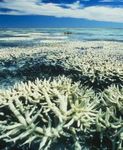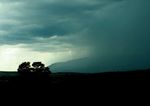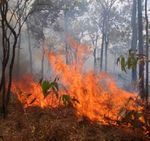Module 2 The impacts of climate change - INTRODUCTION - The Australia Institute
←
→
Page content transcription
If your browser does not render page correctly, please read the page content below
x
Module 2 The impacts of climate change
INTRODUCTION
The impacts of climate change are and rapid the change may be, but
already being felt. The emission of also on how vulnerable or adaptable
greenhouse gases by human activities the system is.
is resulting in increased surface
temperatures that are causing multiple Secondly, predictions of warming are
and complex changes to the climate based on climate models, which can
at both a global and regional scale. vary significantly. Global precipitation
(rainfall and snow) for example, is
When we think about climate change expected to increase by between 1
there are two important points to and 9 per cent by 2100. Such TEMPERATURE
remember. Firstly, climate change differences make it more difficult to
affects both natural and human predict how serious and/or long lasting
systems. The impacts that are felt possible impacts may be, and how large In 2007 the Intergovernmental Panel on Climate Change (IPCC), described in
will not only depend on how large an area will be affected. Module 4, released its latest report on climate change. It found that:
• in the last 100 years the earth has warmed by 0.74°C;
• eleven of the last twelve years (1995-2006) rank among the twelve
warmest years since 1850; and
• there is a risk that by the end of the 21st Century temperatures could rise
by between 1.1 and 6.4°C.
Climate models tend to show that the greatest warming will occur over inland areas
of continents and in the northern hemisphere (because of the greater proportion
of land mass). By contrast, less warming will occur over oceans and coastal zones.
The least warming will occur over the Southern Ocean because of its large capacity
to transport surface heat into deeper waters.
It is also expected that warmer conditions will occur along the coast of South
America, so that El Nino conditions (which is associated with drought in Australia)
may become more common. Because the Earth’s climate system is so complex,
warming could continue for centuries, even after greenhouse gas concentrations
are stabilised.
Find out about El Nino.
© The Australia Institute, 2008x
Module 2 The impacts of climate change
Increased global temperatures are already associated with a reduction in polar ice,
melting of glaciers and thawing of permanently frozen ground in high latitudes (such
as the Russian tundra).
At a regional or local scale, it is uncertain as to how much climate change will affect
snowfall and the altitude of snowlines, which could likely affect winter sports
like skiing.
Australian data indicates that the length of the snow season and the volume
of snow is decreasing over time. On the other hand, warmer air can hold more
moisture, so it is possible that in humid areas (such as the South Island of New
Rising sea levels
Zealand), warming could be associated with increased snowfall.
The increase in ocean temperatures will not only melt polar ice and glaciers, it
will also make the volume of water in oceans expand. Both of these processes
contribute to rising sea levels. As waters rise, there is a greater risk of the edges of
Substances called gas hydrates (icelike solids in which gas molecules are
ice shelves and coastal glaciers collapsing into the sea, thereby causing further sea
trapped) are locked up in water within frozen ground. It is estimated that
level rise.
gas hydrates contain twice the total volume of carbon in existing coal, oil and
gas deposits on Earth. Thawing of frozen ground due to global warming may Due to historically favourable climatic conditions, coastal zones throughout the
destabilise these substances, which would release large volumes of methane world are densely populated. In Australia, 84 per cent of the population lives on
back into the atmosphere, further enhancing the greenhouse effect. the coast. Rising sea levels will place some of these people at risk, due not only
to waterlogging and submergence of land, but also to damage by wave action and
storm surges.
The environments most vulnerable to sea level rise are low-lying oceanic islands,
particularly island atolls, and river deltas, such as the Ganges delta in Bangladesh.
In these localities, rising sea levels are already causing groundwater levels to rise,
and submergence during high tides are becoming more frequent. Concerns are
now emerging that many island atolls will become uninhabitable, forcing migration
of human populations and extinctions of island fauna and flora.
© 2007 Gary Braasch
© The Australia Institute, 2008x
Module 2 The impacts of climate change
Extreme events Water quantity & quality
Changes in global temperatures will also lead to more frequent extreme climate In Australia, the increased incidence of drought and reduced runoff will affect water
events. It is anticipated that the number of very hot days will increase with fewer supply to farmers, irrigators and cities. In a drying environment, water use by crops
colder and frosty days. In addition, intense summer heat could result in more will increase, creating a greater demand for irrigation water. However, there will be
violent storms and tropical cyclones as the oceans warm and more energy is stored less runoff filling storage dams so it will become increasingly difficult to meet those
in our warming atmosphere. This could cause greater flooding, mud/land slides, and demands.
damage to buildings, roads and bridges.
Under these conditions, water will become an increasingly precious resource.
By contrast, in the mid latitudes, particularly in inland regions, more frequent and Water of high quality will be particularly valuable, since a decrease in the amount of
prolonged drought could be associated with reduced water supply, lost productivity water flowing through rivers and streams will affect the water quality. For example,
and possibly famine. In addition, drier conditions will cause more frequent and the salt content (salinity) could increase.
higher intensity bushfires.
A Case Study: Bushfires Recent projections indicate that
climate change could raise the risk
Each December, as Australians of fire in Australia. According to the
begin their summer holidays, their CSIRO, climate change will increase
television screens invariably begin the frequency of very high and
to show pictures of bushfires extreme fire danger days by 4-25 per
threatening lives and property. cent by 2020 and 15-70 per cent by
In January and February, it is not 2050 across south-east Australia.
uncommon to hear reports of fire
fighters attempting to control many
fires as resources criss-cross the
country to assist those most in need.
The most recent and devastating
of these episodes was the 2002-03
fire season. Over three million
hectares of bushland and vegetation
were destroyed across the country.
In Canberra, the worst affected city,
four people died, 501 houses were
lost and over 160,000 hectares
were burnt.
© The Australia Institute, 2008x
Module 2 The impacts of climate change
Ecosystems & biodiversity
Ecosystems throughout the world are already experiencing unprecedented
pressures from human activities that make them increasingly vulnerable and less
capable of adapting to ongoing changes, including climate change. In the next
hundred years ecosystems will be exposed to the highest CO2 concentrations
for 650,000 years, and the highest global temperatures in 740,000 years. These
conditions will reduce biodiversity (the number of plant and animal species present),
and the function of most ecosystems.
An ecosystem is a complex community of animals, plants and
micro-organisms which interact with the non-living environment (such as soil,
rock and water). Ecosystems are essential to human wellbeing and to overall
Human health & wellbeing
environmental health. Human health, safety and living standards will be increasingly affected by climate
change. There are likely to be more instances of heat-wave induced illness and
death such as the 2003 summer heatwave in Europe that killed an estimated
About 20-30 per cent of plant and animal species would be at risk of extinction if 35,000 people. Conversely, in the Northern Hemisphere there may be fewer deaths
global temperatures rise 2-3oC above pre-industrial levels. In marine environments, related to cold weather. Loss of life, injury and loss of infrastructure from natural
sea water will be warmer and carry more dissolved CO2 (making it more acidic) and disasters such as fire, flood, drought, landslides and storms could increase as well.
hence more difficult for some species to live.
Secondly, sea level rise will be associated with increased risks of inundation, storm
surges and the failure of sanitation systems. This can lead to loss of productive
land, and associated food shortages, an increase in disease, and loss of fish
nurseries (also an important food source).
Indirect, longer term impacts include a change in the incidence and distribution
of infectious diseases, especially those that are transmitted through animals
and insects that carry human disease. These include malaria, dengue fever and
rabies. Where drier conditions develop, a higher incidence of respiratory disease
associated with pollen and dust can be anticipated.
A word of caution relating to human health issues: while these impacts
have been identified, there is little hard evidence to date of the effects of
observed climate change on health.
Dust storm rolls across Queensland in freak storm that kicked up drought dust. © 2005 Gary Braasch
© The Australia Institute, 2008x
Module 2 The impacts of climate change
Figure 1 Impacts of climate change on ecosystems
4.5
At 4ºC there are major extinctions around the globe, including the likely extinctions of
200-300 species of New Zealand alpine plants.
Most ecosystems cannot adapt to the climate changes. 15-40 per cent of endemic
3.5 species in global biodiversity hotspots will become extinct.
Coral becomes extinct as reefs are overgrown by algae; As Figure 1 shows, the projected impacts of climate change are many, and could
∆T (ºC) above pre-industrial
Around the world 21-52 per cent of species are committed to extinction and there is a be expressed either as rapid shifts or slow, progressive changes. Some of the
high risk of extinction to polar bears. The terrestrial biosphere could also become a net
carbon source. changes may be manageable, particularly if greenhouse gas emissions stabilise, but
Major loss of Amazon rainforest and its biodiversity;
others will be irreversible.
2.5 Loss of 13-80 per cent of various fauna in South Africa;
41-51 per cent loss of endemic plants in South Africa, Namibia; The Great Barrier Reef is a world
Loss of 47 per cent of rainforest habitat in Queensland;
All coral reefs bleached;
heritage site located off the coast
9-31 per cent of species committed to extinction. of Queensland. Home to a network
1.5 of some 2,900 reefs, thousands of
Loss of 8 per cent of freshwater fish habitat in North America. species and seagrass meadows, it
Polar ecosystems increasingly damaged; is now under threat from climate
Increased coral reef bleaching; change. For example, higher
Amphibian extinctions increasing on mountains. temperatures, and the number of
0.5 extremely hot days (above 35oC)
create the risk of coral bleaching
leading to coral death. In addition,
0.0 more severe tropical storms could
physically damage sections of the
-0.5 reef. Any destruction of the reef is
also likely to affect the thousands
of people employed in tourism in
0
00
00
0
21
19
20
and around the reef.
© Greenpeace/Roger Grace
Source: IPCC, 2007.
Great Barrier Reef Australia © 2005 Gary Braasch © The Australia Institute, 2008x
Module 2 The impacts of climate change
STUDENT ACTIVITIES Exercises
Complete the table below to indicate the types of extreme events that may take
Comprehension Questions place in response to climate change, and the impacts these events may have on
plants, animals and humans.
• Write in your own words how the impacts of climate change are likely to affect
different parts of the world.
• What are the major risks from climate change for people living in low lying
Type of Impacts on animals,
coastal areas?
extreme event plants and/or humans
• Evaluate one climate-related risk faced by Australia. For example, the risk of
bushfires, droughts or storm surges. Identify what effect potential climate Increasing
changes could have on this risk. temperatures
Analysis Questions Increasing
precipitation
• How can human activities affect ecosystems? Explain your answer with Decreasing
reference to an ecosystem that is under threat from climate change. precipitation
• Consider an ecosystem in your own area. Describe the ecosystem in detail. Rising
What are the potential impacts on this ecosystem that might result if sea level
temperatures increased and rainfall decreased?
© The Australia Institute, 2008You can also read


























































